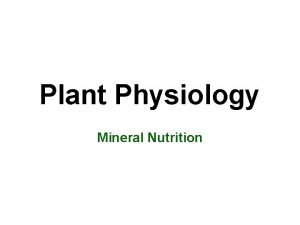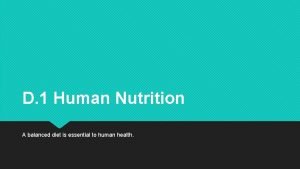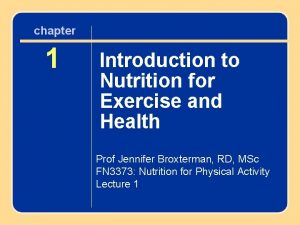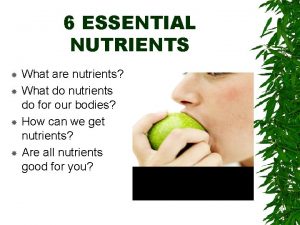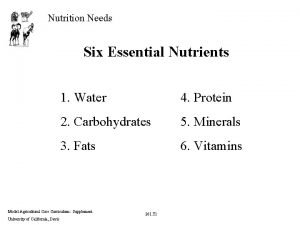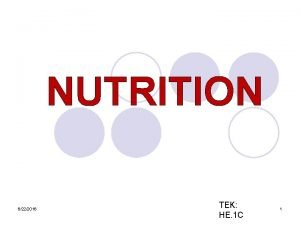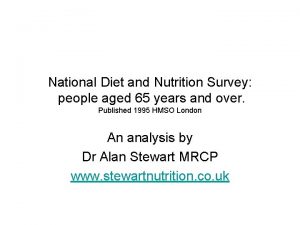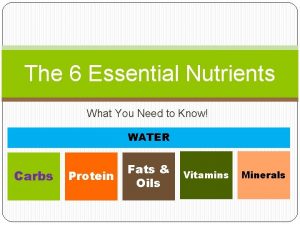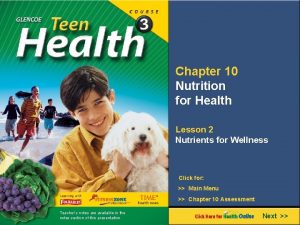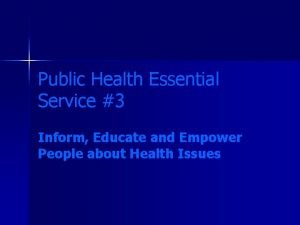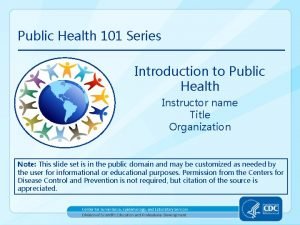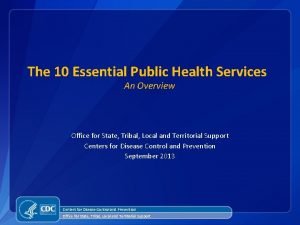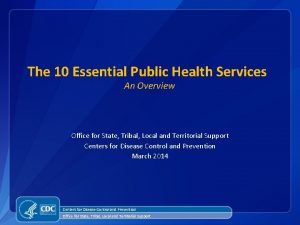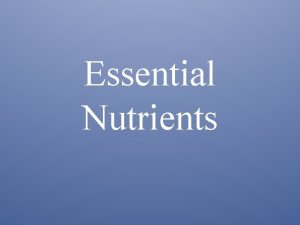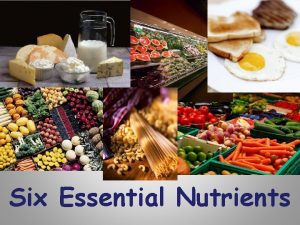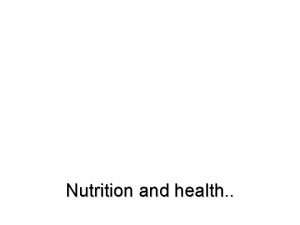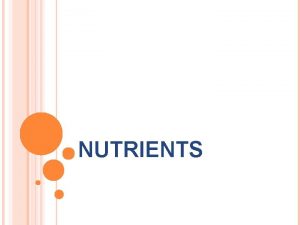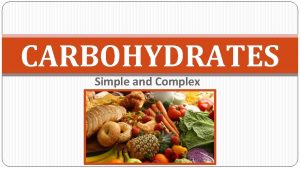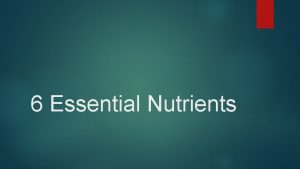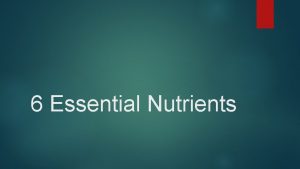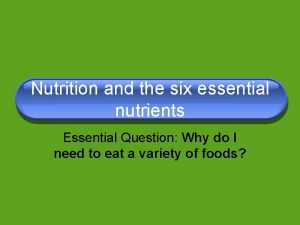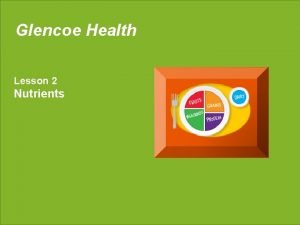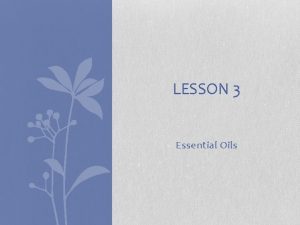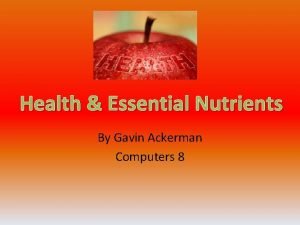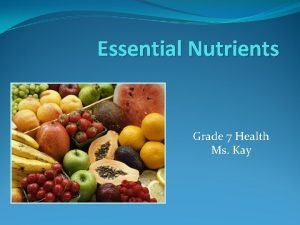Nutrients Essential for Health Nutrients n Major nutrients


















































- Slides: 50


Nutrients Essential for Health

Nutrients n Major nutrients in food are classified into six groups. They work in partnership for health. n Carbohydrates n Fats n Proteins n Vitamins n Minerals n Water

Carbohydrates Your body’s main source of energy or calories. n Classified in two groups: complex carbohydrates or sugars. n Fiber (a form of complex carbohydrate) aids in digestion and offers protection from diseases. n

From Complex to Simple n All carbohydrates – sugars and starches – break down to simple sugars during digestion. Simple sugars are glucose, galactose and fructose. n Glucose is the main form of carbohydrate used for energy.

Energy Storage The body doesn’t burn all glucose at the same time. Some gets stored in muscles and liver as glycogen. Some glucose also may be converted to body fat – if you consume more calories than your body needs. n 1 gram of carbohydrate = 4 calories n

Carbohydrate Foods n Foods with complex carbohydrates form the foundation of a healthful diet

Fiber Your body’s broom!!! n Not a nutrient because it cannot be absorbed, but it is very important. n It bulks up the contents of intestines. n High-fiber foods – legumes, whole-wheat bread, bran, many cereals, strawberries, Brussels sprouts, most fruits and vegetables, popcorn, grains, nuts, seeds. n

Fiber n We need about 25 grams per day. n Most Americans get about 14 grams per day.

Fats n Supply energy, but also have other functions Transport nutrients n Support growth n Part of many body cells n n Made of fatty acids (some fatty acids are more saturated than others).

Fats supply 9 calories per gram. n Extra fat in the diet is stored as adipose tissue. n Fats give a smooth creamy texture to foods. n Fats make you feel full. n

Types of Fat n Monounsaturated – liquid at room temperature. Canola, nut, and olive oils are high in this fatty acid. n Polyunsaturated – liquid or soft at room temperature. Corn, safflower, soybean and sunflower oils. Fats in seafood are mainly polyunsaturated.

Types of Fat n Saturated – firm at room temperature and are from animal foods and coconut, palm and palm kernel oils. n Trans fatty acids: formed during the process of hydrogenation in which unsaturated fats are made saturated. Found naturally in some foods. Extends shelf life of products.

Fats Most all foods contain fat in varying amounts. Some are very high in fat; others have just trace amounts. n Be sure to check food label for fat content. n Limit total fat intake to no more than 20% to 35% of calories and saturated fat to no more than 10% of calories. n

Protein Supply amino acids that are building blocks of maintaining and repairing body tissue. n The body makes nonessential amino acids; others are essential in food. n Proteins provide energy when carbohydrates and fat are in short supply. n

Protein Foods Lean meat, poultry, fish, eggs, dry beans, tofu, nuts, peanut butter, dairy foods n Protein foods are great sources of iron, zinc, B vitamins. n

Water Regulates body processes n Carries nutrients and other body chemicals n Carries waste products away n Regulates body temperature n Makes up 45% – 75% of body weight n

Water To keep your body functioning normally and to avoid dehydration, your body needs an ongoing water supply. n The average adult loses about 2 ½ quarts of water daily – more in hot weather. n Total Fluid Intake Daily: n Males (19 & Over) – 3. 7 liters (125 ounces) n Females (19 & Over) – 2. 7 liters (91 ounces) n

Water n Thirst signals the need for water, but it isn’t a foolproof mechanism, especially for the elderly, children or during hot weather, illness or exercise.

To increase water supply… Take water breaks during the day. n Drink water with meals. n Alternate sparkling water for soft drinks. n Carry water with you. n Drink before, during, and after exercise. n

Vitamins and Minerals The Real Team Players!

Vitamins and Minerals n Called micronutrients. n Don’t let the small amount fool you – They regulate many processes that produce energy and do a whole lot more.

Vitamin Basics Complex organic substances that regulate body processes n Often act as coenzymes n Two categories: water soluble and fat soluble n Water-soluble vitamins: B-complex vitamins and vitamin C n Fat soluble vitamins: A, D, E and K n

Antioxidant Vitamins ACE – vitamins A, C and E n Slow or prevent the oxidative process n Prevent or repair damage to body cells n May improve immune function n

Minerals n Not “Heavy Metal”

Major Minerals Needed in greater amounts n More than 250 milligrams recommended daily n Calcium, phosphorus and magnesium n Electrolytes – sodium, chloride and potassium n

Trace Minerals Body needs small amounts – less than 20 milligrams daily. n Chromium, copper, fluoride, iodine, iron, manganese, molybdenum, selenium and zinc. n Others are identified, but less is known about their role in health. n All are absorbed in the intestines and transported and stored in parts of the body. n

Major Minerals - Calcium Builds bones in length and strength n Slows the rate of bone loss n Reduces risk of osteoporosis n Helps muscles contract and heart beat n Plays a role in nerve function n Helps the blood clot n

Calcium – How Much? n How much do you need? Age Amount per day 9 – 18 1, 300 mg Adult – 50 1, 000 mg Over 50 1, 200 mg

Sources of Calcium Milk and other dairy foods n Dark green, leafy vegetables n Fish with edible bones n Calcium-fortified foods n

Major Minerals - Sodium Electrolyte: Helps regulate movement of body fluids n Helps muscles relax (including your heart) n Helps transmit nerve impulses n Helps regulate blood pressure n

Sodium – How Much? Tolerable upper intake level – 2, 300 mg daily. n 1 teaspoon salt = almost 2, 300 mg n n ¼ teaspoon salt = 500 mg. Sources: processed foods, table salt, some naturally occurring in foods. n Check the ingredient list for Na, salt, soda or sodium in the name. n

Sodium – Label Lingo Sodium-free – less than 5 mg per serving n Very low sodium – 35 mg or less per serving n Low sodium – 140 mg or less per serving n Reduced or less sodium – at least 25% less sodium n

Trace Minerals - Iron Serves as essential part of hemoglobin and other enzymes n Helps in brain development n Supports a healthy immune system n

Iron – How Much? n RDA for Iron Age Gender mg daily 14 – 18 Males 11 14 – 18 Females 15 Adult Males 19 – 50 Females 18 51 + Females 8 8

Sources of Iron n Heme iron – animal sources n n Meat, poultry, fish Nonheme iron – plant sources Leafy green vegetables n Dried peas n Enriched breads and cereals n

Phytonutrients n Also called Phytochemicals – means plant chemicals n Compounds in plant-based foods n Appear to promote health

Phytonutrients – How Do They Work? Serve as antioxidants n Enhance immunity n Enhance communication among body cells n Cause cancer cells to die n Detoxify carcinogens n Repair damage to DNA n

Vitamin and Mineral Supplements n Do you really need them?

Dietary Supplements n What are they?

Supplements? n Do you consume a varied, balanced diet? Are you healthy? n If you answered yes to both of these questions, you probably get all the vitamins and minerals you need from the foods you eat.

Supplements? Under some circumstances, multivitamin/mineral supplements do offer benefits. Follow your doctor’s advice.

Supplements May Be Needed For. . . Women who are pregnant or breastfeeding n Women of childbearing age n Women with heavy menstrual cycles n Menopausal women n Vegetarians n People with limited milk intake and sunlight exposure n

Supplements (cont) Someone on a restrictive diet n Persons who do not eat a balanced diet n Persons with illnesses that affect nutrient use n Some babies after age 6 months, children and teens n In all situations, your doctor’s opinion should be requested.

Supplement Labeling Serving size and Daily Value labeling is listed n Other ingredients used are also listed n n FDA Final Rule – promotes safe use of Dietary Supplements

If You Take a Supplement: Talk with your doctor before using a dietary supplement. n Know that some supplements may interact with prescription and over-thecounter medicines. n Inform your doctor about all the supplements you use, especially before surgery. n Report adverse effects from the use of dietary supplements to Med. Watch. n

If You Take a Supplement: n Stick with the label dosage and heed warnings. n Follow the label directions. n Keep in a safe, cool, dry place. n Check the expiration date.

Nutrients – Essential for Good Health! Our bodies need 6 classes of nutrients. n A balanced diet with a variety of foods supplies nutrients needed for good health. n Consume high-fat foods in moderation. n Always consult your physician about supplement use. n

Reference: American Dietetic Association Complete Food and Nutrition Guide (3 rd Edition) by Roberta Larson Duyff, MS, RD, FADA, CFCS FDA Consumer Health Information www. fda. gov Presentation Developed By: Cathy Agan, Extension Agent (FNP) Ouachita Parish

 Sunflower bud
Sunflower bud Essential vs nonessential nutrients
Essential vs nonessential nutrients Non-essential nutrients
Non-essential nutrients Non-essential nutrients
Non-essential nutrients Non-essential nutrients
Non-essential nutrients What are 6 essential nutrients
What are 6 essential nutrients Six essential nutrients
Six essential nutrients Six classes of food
Six classes of food Classification of essential nutrients
Classification of essential nutrients 6 essential nutrients
6 essential nutrients Essential non essential fatty acids
Essential non essential fatty acids 7 major nutrients
7 major nutrients Chapter 10 lesson 2 nutrients
Chapter 10 lesson 2 nutrients Core functions and essential services of public health
Core functions and essential services of public health Core functions and essential services of public health
Core functions and essential services of public health Kenya high priority health packages
Kenya high priority health packages Mental health essential questions
Mental health essential questions Essential questions about mental health
Essential questions about mental health 10 essential public health services
10 essential public health services 10 essential public health services
10 essential public health services 10 essential services
10 essential services Formuö
Formuö Novell typiska drag
Novell typiska drag Tack för att ni lyssnade bild
Tack för att ni lyssnade bild Ekologiskt fotavtryck
Ekologiskt fotavtryck Varför kallas perioden 1918-1939 för mellankrigstiden?
Varför kallas perioden 1918-1939 för mellankrigstiden? En lathund för arbete med kontinuitetshantering
En lathund för arbete med kontinuitetshantering Underlag för särskild löneskatt på pensionskostnader
Underlag för särskild löneskatt på pensionskostnader Tidbok yrkesförare
Tidbok yrkesförare A gastrica
A gastrica Vad är densitet
Vad är densitet Datorkunskap för nybörjare
Datorkunskap för nybörjare Stig kerman
Stig kerman Mall för debattartikel
Mall för debattartikel Delegerande ledarskap
Delegerande ledarskap Nyckelkompetenser för livslångt lärande
Nyckelkompetenser för livslångt lärande Påbyggnader för flakfordon
Påbyggnader för flakfordon Arkimedes princip formel
Arkimedes princip formel Offentlig förvaltning
Offentlig förvaltning Urban torhamn
Urban torhamn Presentera för publik crossboss
Presentera för publik crossboss Argument för teckenspråk som minoritetsspråk
Argument för teckenspråk som minoritetsspråk Bat mitza
Bat mitza Treserva lathund
Treserva lathund Fimbrietratt
Fimbrietratt Bästa kameran för astrofoto
Bästa kameran för astrofoto Cks
Cks Verifikationsplan
Verifikationsplan Mat för idrottare
Mat för idrottare Verktyg för automatisering av utbetalningar
Verktyg för automatisering av utbetalningar Rutin för avvikelsehantering
Rutin för avvikelsehantering
